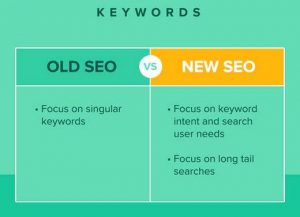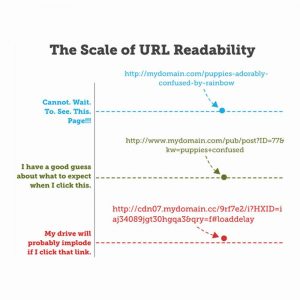February 06, 2019
5 SEO Mistakes to Avoid During a Website Redesign
Do you know that goldfish have a longer attention span than humans? This is a very important fact to take into consideration when you think of building a website, or redesigning an existing one.
Redesigning a website is not about just changing aesthetics, there’s a lot more involved. No matter how creatively it is designed- if your audience fails to find your site on Google search or has difficulty in navigation, it’s a loss for your brand. And this is where SEO comes in. The SEO part is not glorified during a website redesign and a lot of times one can miss out on important aspects that can later adversely impact the website.
Here are 5 common SEO mistakes that one should avoid during a website redesign -
 Source: Neil Patel[/caption]
Source: Neil Patel[/caption]
 Source: SEO Mechanic[/caption]
Source: SEO Mechanic[/caption]
 Source: Medium[/caption]
Responsive design enables the URL of your website to be the same across every device with the same HTML code. This configuration enables Google to crawl through pages and retrieve content easily. “This improvement in crawling efficiency can indirectly help Google index more of the site’s contents and keep it appropriately fresh.”
Source: Medium[/caption]
Responsive design enables the URL of your website to be the same across every device with the same HTML code. This configuration enables Google to crawl through pages and retrieve content easily. “This improvement in crawling efficiency can indirectly help Google index more of the site’s contents and keep it appropriately fresh.”
 Source: Fiverr[/caption]
Keeping a record of these important metrics will help in analysing where the website needs work and accordingly it can be redesigned.
SEO is a very cost-effective and efficient way to bring your website into the limelight to be discovered by your target audience - which in turn will help you grow your business and drive revenue. To know more on how to effectively use SEO to your advantage, leave us a message and we’ll get back to you.
Source: Fiverr[/caption]
Keeping a record of these important metrics will help in analysing where the website needs work and accordingly it can be redesigned.
SEO is a very cost-effective and efficient way to bring your website into the limelight to be discovered by your target audience - which in turn will help you grow your business and drive revenue. To know more on how to effectively use SEO to your advantage, leave us a message and we’ll get back to you.
1. Neglecting SEO from the beginning
The most common and undoubtedly biggest mistake during a website redesign is not considering SEO from the very beginning. Often, the SEO team is involved when the website has reached the stage of coding or is totally complete. However, this can prove to be costly for your business if there are last-minute SEO changes in both design and coding. SEO does not only mean keywords, but it also includes metadata, content on the website, taglines, imagery, CTA’s, etc. So ensure to involve the SEO team in the redesign process from the early stages itself.2. Missing out on commonly searched keywords
“Successful SEO is not about tricking Google. It’s about partnering with Google to provide the best search results for Google users.” Keywords are the most important aspect of SEO as it helps to keep your website focused. However, the best way of adding value to every page for your users is to focus on ‘one term per page’. Excessive keywords can do more harm than good. Google has the ability to recognize sites that overuse or jam unnecessary keywords in their pages and this can greatly affect your credibility and search engine ranking. The best way to infuse keywords is to fill it naturally in your high-quality content. Ensure the content describes the topic accurately. Identify the keywords that users are more likely to use and include them in the relevant pages. [caption id="attachment_10856" align="aligncenter" width="500"] Source: Neil Patel[/caption]
Source: Neil Patel[/caption]
3. Not paying attention to the URL structure
Search engines will always prefer URLs that comprehensively explain what your website content is about. If your site contains unaligned, indecipherable and lengthy URLs, ensure to get them all corrected during the website redesign. Tip: Use dashes (-) instead of underscores (_) in between words, as Google reads dashes as separators. This way, your pages are more likely to be discovered on search results. [caption id="attachment_10857" align="aligncenter" width="500"] Source: SEO Mechanic[/caption]
Source: SEO Mechanic[/caption]
4. Not focusing on responsive design
Google prefers mobile-optimized sites and therefore, having a responsive website design is one of the best ways to deliver a great browsing experience to users. [caption id="attachment_10858" align="aligncenter" width="500"] Source: Medium[/caption]
Responsive design enables the URL of your website to be the same across every device with the same HTML code. This configuration enables Google to crawl through pages and retrieve content easily. “This improvement in crawling efficiency can indirectly help Google index more of the site’s contents and keep it appropriately fresh.”
Source: Medium[/caption]
Responsive design enables the URL of your website to be the same across every device with the same HTML code. This configuration enables Google to crawl through pages and retrieve content easily. “This improvement in crawling efficiency can indirectly help Google index more of the site’s contents and keep it appropriately fresh.”
5. Not doing an audit of the existing website
Auditing the website before revamping it is extremely important to make sure that you know the strengths and weakness of your site. The most important metrics that you need to consider would be -- The top-performing keywords (based on traffic, rank and lead generation)
- Number of monthly visitors / unique users
- Inbound linking domains
- Total number of pages that are indexed
- Total number of pages that receive traffic
 Source: Fiverr[/caption]
Keeping a record of these important metrics will help in analysing where the website needs work and accordingly it can be redesigned.
SEO is a very cost-effective and efficient way to bring your website into the limelight to be discovered by your target audience - which in turn will help you grow your business and drive revenue. To know more on how to effectively use SEO to your advantage, leave us a message and we’ll get back to you.
Source: Fiverr[/caption]
Keeping a record of these important metrics will help in analysing where the website needs work and accordingly it can be redesigned.
SEO is a very cost-effective and efficient way to bring your website into the limelight to be discovered by your target audience - which in turn will help you grow your business and drive revenue. To know more on how to effectively use SEO to your advantage, leave us a message and we’ll get back to you. 


